You are gathering feedback, but it is all over the place. Surveys and support tickets in one place, and some messages floating around in DMs. And yet, somehow, you keep missing what the customers feel.
This is exactly where the voice of customer (VoC) software can help. It helps you gather, collect, and work on those actual customer perceptions. However, there are probably dozens of tools all vying to do the same job, so your hardest challenge is not even finding a tool, but choosing the right one.
This guide breaks down eight top-rated VoC tools, clearly outlining their pros and real limitations, as well as the best fit for each. It refines your choices so you won’t spend on features you’ll never use or insights you can’t act upon. Let’s dive in.
Highly Rated Voice of Customer Software to Try in 2025
No tools are the same. Everyone is good on their own, but it all depends on your business needs. Here, we have handpicked the top-rated voice of customer software and tools that are worth checking out in 2025:
1. Crescendo.ai
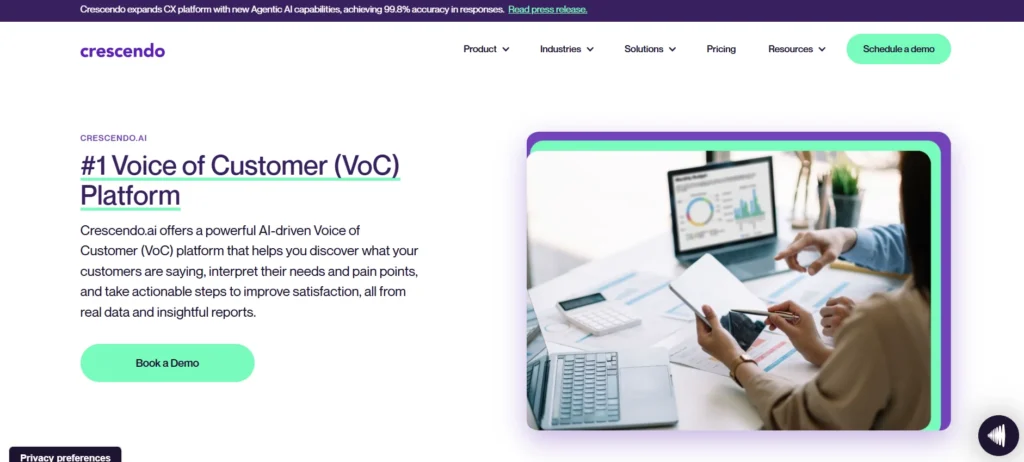
Crescendo.ai has a robust AI-powered Voice of Customer (VoC) platform for customer support tickets received via chat, e-mails, SMS, and voice. Its unique power is its capacity to analyse all the conversations and calculate CSAT, and perform sentiment analysis in real-time using AI without the need for manual surveys.
So, say goodbye to scattered feedback and unreliable surveys with Cresendo.ai. It is an entirely automated and AI-powered Voice of the Customer platform that provides you with deep and instant insights. Whether sorting queries or drilling down into the reasons behind handoffs, it does all the work of converting raw conversations into actionable information, hands down for you, all without ever asking for a bit of physical effort.
On the other hand, it is a full-fledged CX support platform in itself, offering helpdesk software, AI-powered customer support agents, and outsourcing service with real human agents.
Pros:
- Auto-calculates CSAT and sentiment for 100% of conversations without surveys.
- Categorizes issues like billing, refunds, or tech errors for actionable insights.
- Flags reasons for human handoffs to improve workflows and agent training.
- Detects critical issues like fraud, duplicate accounts, or failed transactions.
- CX leaders get an opportunity to measure the surges in specific customer issues across categories.
- Offers multilingual support with seamless integration of translation across 50+ languages.
- It combines AI and human-backed outsourcing services to provide high empathy and context-aware accuracy.
- Starts from $2.99, which is a cost-efficient pricing without sacrificing quality.
- Achieves up to 90% instant resolution rate with 99.8% accuracy, which is the highest in the industry.
Cons:
- No social listening and employee review capacity. Its VoC is made just for customer support queries.
- Though the dashboard is easy to navigate, it might be overwhelming if you are unfamiliar with AI-driven analytics.
2. Zonka Feedback
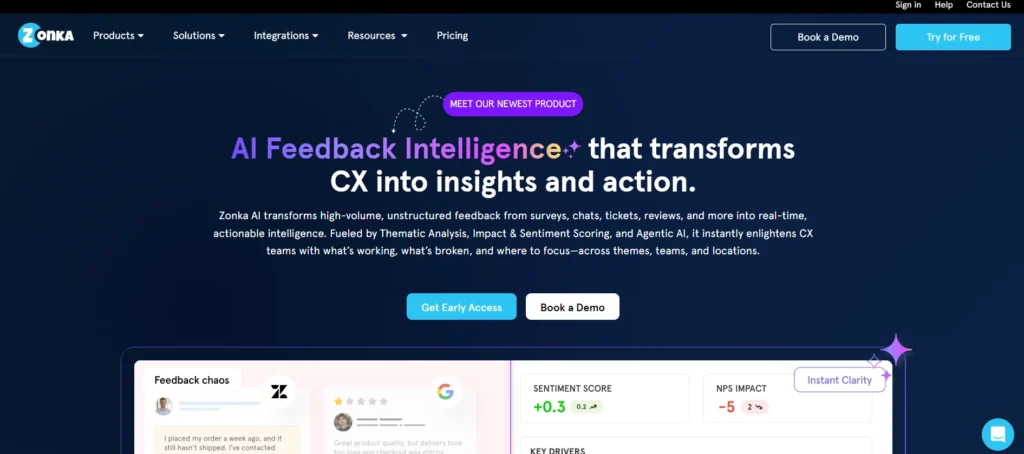
Zonka Feedback is an AI Voice of Customer platform that converts multi-channel unstructured customer feedback into crystal-clear and actionable intelligence. It ingests data from surveys, chats, reviews, tickets, and other sources. It organizes all the information into a single dashboard.
Thematic analysis, sentiment scoring, impact mapping, and role-based dashboards are some of the features that help teams go very deep in identifying root causes, align on actions, and close the feedback loop with practically zero manual work. Zonka brings clarity across locations, teams, and touchpoints.
Pros:
- Auto-tags feedback by location, team, service type, or issue owner so that they can be routed faster.
- Role-based dashboards show only the most important insights to stakeholders.
- AI-driven insights highlight performance drivers linked to NPS, CSAT, CES, and churn.
- Smart workflows automatically assign tasks, escalate issues, and trigger follow-ups.
- Built-in case management tracks progress on resolution and accountability.
Cons:
- Delays in syncing large datasets from third-party platforms.
- Some of the advanced AI capabilities are locked behind a premium tier, which may be prohibitive for smaller teams.
3. Medallia
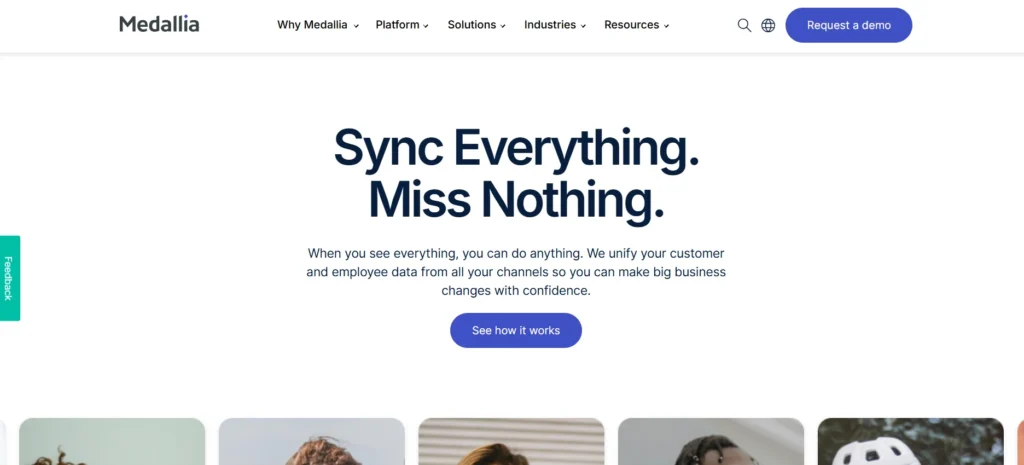
Being one of the leading Voice of Customer and experience management platforms, Medallia captures feedback signals from a multitude of channels — surveys, social media, contact centers, and web — and turns those inputs into real-time, AI-driven insights.
Its built-in AI engine, Athena, allows businesses to deliver experiences akin to personalization at scale, automate workflows, and predict behaviors. Medallia allows front-line and internal teams to close the loop faster, drive retention improvements, and tie feedback into real revenue or cost-savings outcomes across journeys and touchpoints.
Pros:
- Offers real-time AI-driven coaching to front-line teams based on conversation analysis.
- Strong role-based reporting ties every stakeholder to actionable CX steps.
- Gives organizations the power to orchestrate hyper-personalized customer journeys using behavior data.
- Includes industry-specific modules strong in execution and insight (e.g., healthcare, retail, telecom).
- ROI-proven with an application to directly link CX improvements to revenue and cost savings.
Cons:
- A long and winding initial setup and onboarding process for large organizations.
- Some dashboard customizations can only be completed by the vendor rather than being completed through self-service.
4. Qualtrics
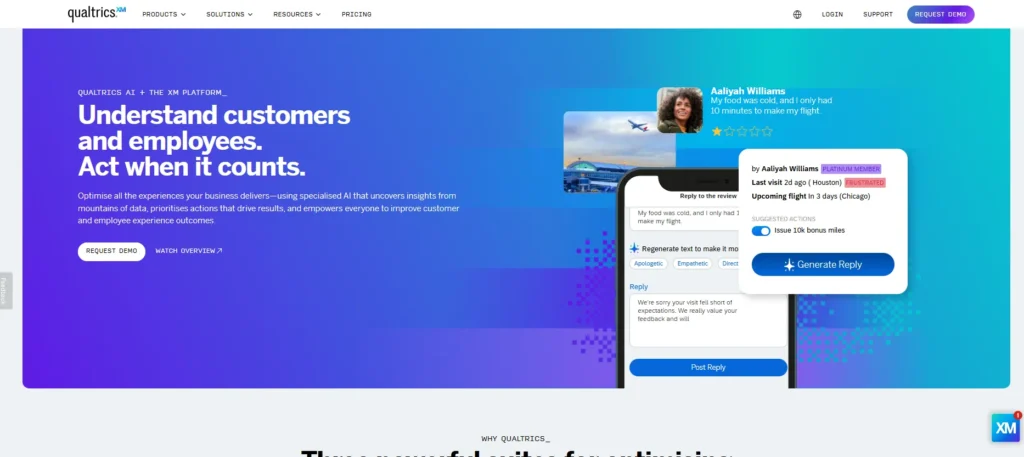
Qualtrics is an Experience Management (XM) or Voice of Customer (VoC) platform used to collect and analyze feedback from customers, employees, and markets and act thereupon. Format-wise, Qualtrics holds tools for CX, EX, and market research to knit together signals across channels to optimize every single touchpoint.
Its AI engine can identify sentiments, pinpoint issues, and empower teams to realize context-specific actions, thus making experiences personal, measurable, and scalable throughout your organization.
Pros:
- Industry-specific CX, EX, and research modules in one platform.
- Insight generation uses AI-based and role-specific criteria for managers, agents, and product teams.
- Integrates voice, text, survey, and behavioral data for 360-degree visibility of feedback.
- Has excellent dashboarding and reporting capabilities powered by advanced, customizable analytics.
- Trusted by over 20,000 enterprises across the globe and proven in domains such as retail, airlines, and finance.
Cons:
- Learning curve for non-technical users, especially when dealing with complex logic.
- It feels laggy sometimes to load all the info within dashboards or to navigate among them, and its performance drops when handling big data from multi-country setups.
5. SentiSum
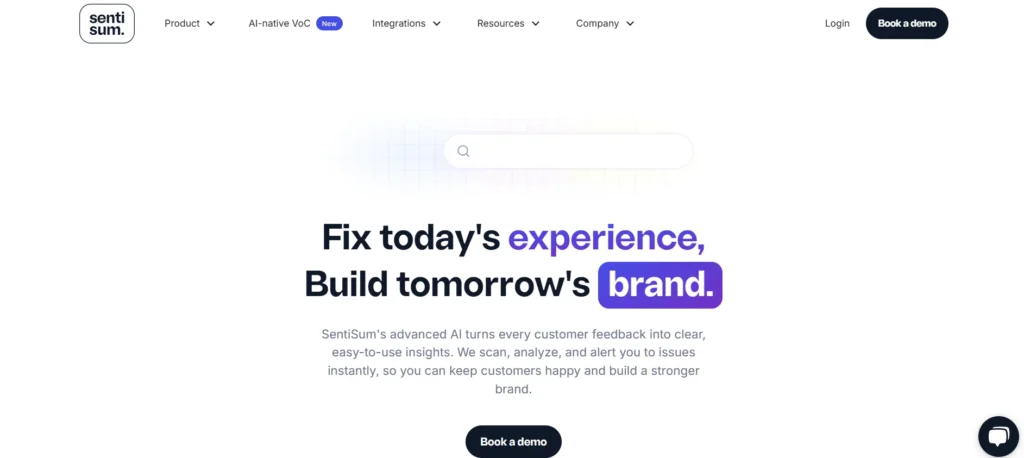
SentiSum is a real-time Voice of Customer platform designed for fast-paced teams requiring instant, lucid insights from customer feedback. Employing advanced AI, it scrutinizes every ticket, chat, review, and survey to identify burgeoning concerns, classifies them automatically, and sets up alerts for brands to act before problems escalate.
It brings data together from across channels with minimal setup and high adoption due to its intuitive design. SentiSum allows businesses to repair problems today and build customer loyalty for tomorrow, without complicated setups.
Pros:
- Real-time scanning of support tickets, chats, and reviews
- Automated alerting to identify unexpected issues (product, service, delivery)
- Consolidates feedback from every touchpoint into one transparent dashboard
- Setup is done in anywhere 2 weeks, with adoption from more than 90% of teams
- Minimal training needed because it’s all very intuitive
Cons:
- Heavy focus on support channels, limited CX journey tools
- A limited number of integrations outside of support platforms such as Zendesk or Intercom
6. UserTesting
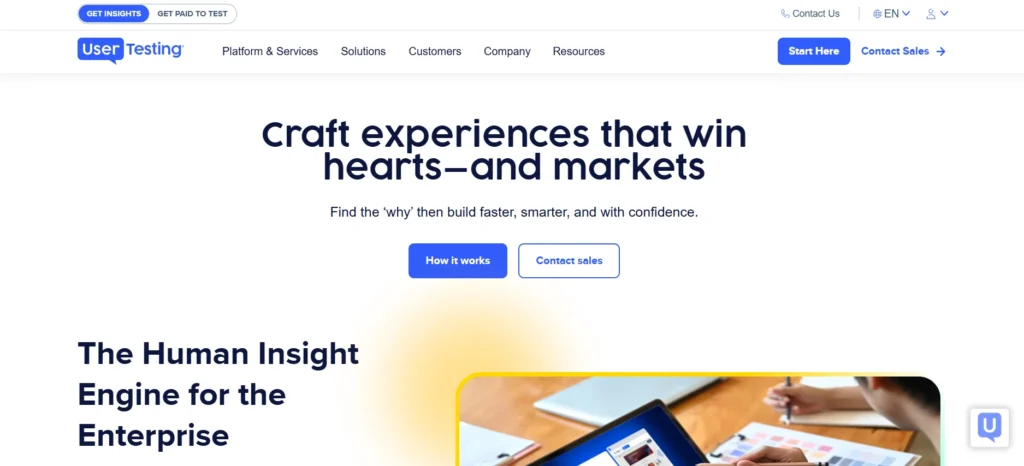
UserTesting is an enterprise-grade, top-rated VoC software enabling organizations to rapidly test digital experiences, marketing campaigns, or product ideas and tune them according to real customer feedback. Being equipped with the most robust global participant network and AI-powered analytical suite, teams can validate and de-risk decisions and launches, working alongside their users in real time.
From product to marketing, and to CX, UserTesting helps make faster and wiser decisions, which improves customer satisfaction, enhances revenue, and builds brand loyalty, all without traditional research that takes months.
Pros:
- Feedback from actual customers and target users in real-time
- Good for validating messages, product designs, and digital flows
- Increases speed of decision-making by up to 5x
- 6x ROIs have been recorded according to some customers’ (Microsoft, Walmart) studies
- Used by multiple teams such as marketing, UX, CX, and production.
Cons:
- Deep UX-level research capabilities are mostly utilized by enterprises
- Live testing formats can add friction to high-speed development cycles
7. AskNicely
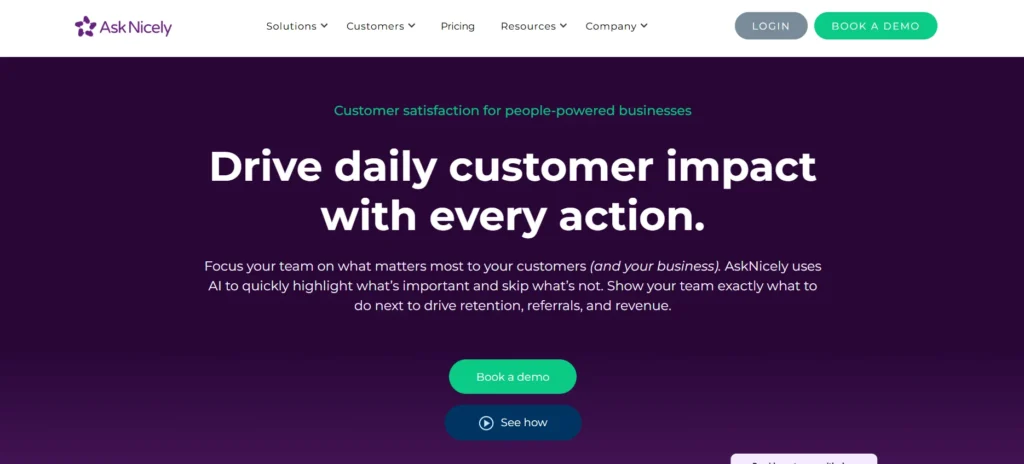
AskNicely is a customer loyalty platform optimized for NPS-powered frontline engagement. It, powered by conversational AI, surveys people over email, SMS, and web, then turns the responses into actionable insights with suggestions for next steps and leaderboards.
Real-time feedback is featured, from which frontline teams can set priorities. Designed to fit in the regular flow of work, it connects with Salesforce, Slack, or Microsoft Teams. AskNicely assists customer-facing teams in prioritizing problems, retention, and improving online reviews—all with little effort and great involvement.
Pros:
- The conversational style of the survey helps in getting more responses.
- Real-time dashboards and leaderboards keep teams motivated.
- Suggested follow-up actions help reps to close the feedback loop.
- Good CRM and collaboration tools integrations – e.g., Salesforce, Slack.
- AI-driven insights automatically highlight key themes.
Cons:
- Integration issues: Users have reported glitches, or at times, they have had to use workarounds.
- Analytics: Reporting does not support strong trend analysis or dashboard customization.
8. SurveySparrow
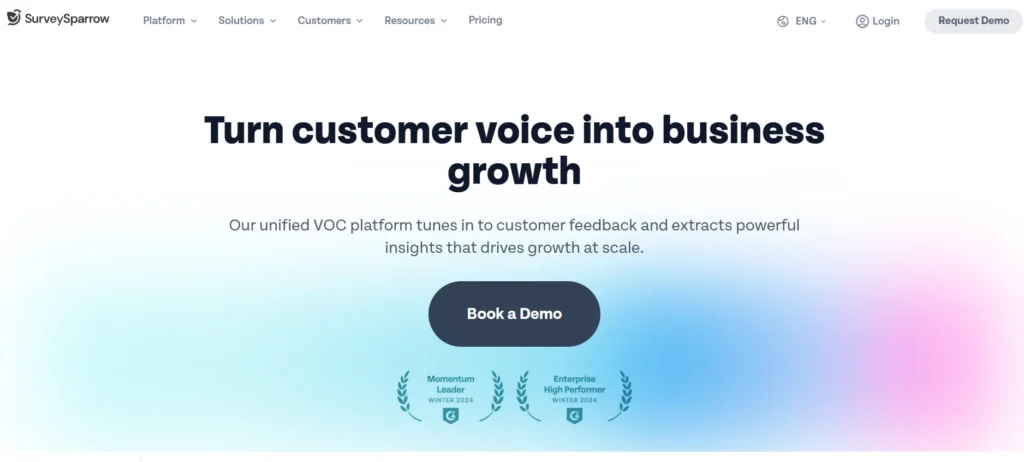
SurveySparrow is an omnichannel Voice of Customer platform that provides businesses with multiple ways to collect feedback through conversational surveys, WhatsApp, emails, social media, and website spot checks.
It has AI-powered smart analytics (CogniVue) that interprets sentiment, key themes, and brand reputation, whereas ticketing, reviews, and reputation management tools close the feedback loop. Its elegant designs and conversational formats promise strong engagement and response rates.
Pros
- Integrated ticketing and reputation management tools close the feedback loop.
- Over 2,000 integrations make the platform flexible to embed into your existing tech stack.
- Strong white-labeling features to ensure brand consistency.
- The Wings AI assistant helps managers with survey creation and review responses.
- Supports multilingual surveys and sentiment tagging in real time.
Cons
- Somewhat limited customization options (especially in lower-tier and free plans)
- The learning curve can be a little steep for beginners in conversational and AI-powered survey logic.
Wrapping Up on VoC Software!
All these great VoC platforms provide an opportunity for brands to tap customer sentiment, close feedback loops, and really effect change. They make listening, learning, and responding easy for businesses, from real-time alerts to insights generated by AI. Choose the platform that not only hears your customers but also truly understands them.



